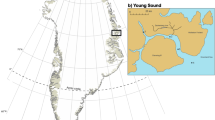Abstract
In order to point out the potential importance of the Kuroshio front as a feeding ground for the early post larvae of the Japanese sardine, distributions of copepod nauplii—the principal food for the larvae—were investigated.
Nauplii were abundant in and near the front and in a warm water mass off Ensyu-nada, where the concentration of chlorophylla was high. Adult females ofParacalanus sp. were dominant in the copepod group there, and the protein synthesis activity shown by the RNA/DNA ratio was high. It is expected that copepod egg productivity is enhanced in the area where food phytoplankton is abundant, because the RNA/DNA ratio showed a positive correlation to chlorophylla in situ.
In and near the front, high chlorophylla concentration—which is probably supported by nutrient supply caused by local upwelling and/or eddies at the front—contributes to the high RNA/DNA ratio of the copepods. The relatively large biomass of copepod nauplii at the front may be supported by female's high egg productivity. It is supposed, as a result, that food availability for the early post larvae of the Japanese sardine is increased in and near the Kuroshio front.
Similar content being viewed by others
References
Aida, K., K. Hirose and M. Yokote (1973): Physiological studies on gonadal maturation of fishes-II histological changes in the liver cells of ayu following gonadal maturation and estrogen administration. Bull. Japan. Soc. Sci. Fish.,39, 1107–1115.
Asami, T. (1962): Studies on the Japanese anchovy,Eugraulis japonicus (Houttuyn), along the coast of Nankai region of Japan. Rep. Nankai Reg. Fish.,16, 1–55.
Båmstedt, U. and H. R. Skjoldal (1976): Studies on the deep-water pelagic community of Korsfjorden, western Norway. Adenosine phosphates and nucleic acids inEuchaeta norvegica (copepoda) in relation to its life cycle. Sarsia,60, 63–80.
Båmstedt, U. and H. R. Skjoldal (1980): RNA concentration of zooplankton: Relationship with size and growth. Limnol. Oceanogr.,25, 304–316.
Brodskii, K. A. (1967): Calanoida of the Far Eastern Seas and polar basin of the USSR. pp. 1–440. (Translation of Brodskii, K. A., 1950, by Israel Program Scient. Trans.).
Checkley, D. M. Jr. (1980a): The egg production of a marine planktonic copepod in relation to its food supply: Laboratory studies. Limnol. Oceanogr.,25, 430–446.
Checkley, D. M. Jr. (1980b): Food limitation of egg production by a marine, planktonic copepod in the sea off southern California. Limnol. Oceanogr.,25, 991–998.
Dagg, M. J. and J. L. Littlepage (1972): Relationships between growth rate and RNA, DNA protein and dry weight inArtemia salina andEuchaet a elongata. Mar. Biol.,17, 162–170.
Hara, I. and T. Watanabe (1987): Distribution and survival of Japanese sardine and their relation to the Kuroshio. International North Pacific Fisheries Commission Bulletin,47, 265–275.
Hirche, H. J. (1989): Egg production of the Arctic copepodCalanus glacialis: laboratory experiments. Mar. Biol.,103, 311–318.
Hjort, J. (1914): Fluctuations in the great fisheries of northern Europe viewed in the light of biological research. P.-v. Reun. Cons. Perm. int. Explor. Mer.,20, 1–228.
Kawai, H. (1969): Statistical estimation of isotherms indicatives of the Kuroshio axis. Deep-Sea Res., Supple. to16, 109–115.
Konishi, Y. (1980): Vertical distribution of eggs and larvae of sardine,Sardinops melanosticta (T. et S.) and round Herring,Erumeus micropus. (T. et S.). Bull. Nansei Reg. Fish. Res. Lab.,12, 93–103 (in Japanese).
Kuroda, K. (1986): Distributional properties of ichthyoplankton, especially the Japanese sardine and the Pacific mackerel eggs and larvae near the Kuroshio front south of Cape Shionomisaki, southern Japan. Bull. Tokai. Reg. Fish. Res. Lab.,119, 109–122 (in Japanese).
Lasker, R. (1981): The role of stable ocean in larval survival and subsequent recruitment. p. 80–87.In: Marine fish larvae, ed. by R. Lasker, University of Washington Press.
Lowry, O.H., N.J. Rosebrough, A.L. Farr and R.J. Randall (1951): Protein measurement with the Folin Phenol reagent. J. Biol. Chem.,193, 265–275.
Nakai, Z. and H. Hattori (1962): Quantitative distribution of eggs and larvae of the Japanese sardine by year, 1949 through 1951. Bull. Tokai. Reg. Fish. Res. Lab.,9, 23–60.
Nakano, H. (1988): Techniques for studying on the early life history of fishes. Aquabiology,10, 23–26. (in Japanese).
Nakata, K. (1988): Alimentary tract contents and feeding conditions of ocean-caught post larval Japanese sardine,Sardinops melanostictus. Bull. Tokai Reg. Fish. Res. Lab.,126, 11–24.
Parsons, T.R., K. Stephens and J.D.H. Strickland (1961): On the chemical composition of eleven species of marine phytoplankters. J. Fish. Bd. Canada,18, 1001–1016.
Sasaki, K., K. Yamashita and K. Kuroda (1985): Fine distributions of nutrients in the Kuroshio front, South of Cape Shionomisaki, Japan. Bull. Tokai Reg. Fish. Res. Lab.118, 1–10 (in Japanese).
Shimizu, H., K. Nakata and H. Nakano (1988): Comparison of nutritional condition of Sardine larvae,Sardinops melanostictus (T & S) taken from the coastal and offshore region of the Kuroshio current. Nippon Suisan Gakkaishi,55, 179.
Uye, S. (1980): Development of neritic copepodsAcartia clausi andA. steueri. II. Isochronal larval development at various temperatures. J. Plankton Res.,27, 11–18.
Uye, S. (1981): Fecundity studies of neritic calanoid copepodsAcartia clausi Giesbrecht andA. steueri Smirnov: A simple empirical model of daily egg production. J. Exp. Mar. Biol. Ecol.,50, 255–271.
Watanabe, T. (1965): Ecological distribution of rhynchoteuthion larvae of common squid,Todarodes pacificus (Steenstrup), in the southwestern waters off Japan during the winters, 1959–1962. Bull. Tokai Reg. Fish. Res. Lab.,43, 1–12.
Yamamoto, T. and S. Nishizawa (1986): Small-scale zooplankton aggregations at the front of a Kuroshio warm-core ring. Deep-Sea Res.,33, 1729–1740.
Yamamoto, T., A. Taniguchi and S. Nishizawa (1988): Formation and retention mechanisms of phytoplankton peak abundance in the Kuroshio front. J. Plankton Res.,10, 1113–1130.
Yentsch, C.S., and D.W. Menzel (1963): A method for the determination of phytoplankton chlorophyll and phaeophytin by fluorescence. Deep-Sea Res.,10, 221–231.
Author information
Authors and Affiliations
Rights and permissions
About this article
Cite this article
Nakata, K. Abundance of nauplii and protein synthesis activity of adult female copepods in the Kuroshio front during the Japanese sardine spawning season. Journal of the Oceanographical Society of Japan 46, 219–229 (1990). https://doi.org/10.1007/BF02124909
Received:
Revised:
Accepted:
Issue Date:
DOI: https://doi.org/10.1007/BF02124909



